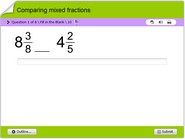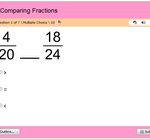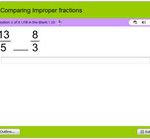Comparing mixed fractions quiz
In Comparing mixed fractions exercise you will learn how to compare mixed fractions in easy way?
Math quiz online for children to learn how to compare mixed fractions
This is an interactive online math quiz to test kids skills on how to compare mixed fractions. In this quiz, children will solve the problem, fill in the correct answer and submit. This quiz can be taken by children in 3rd, 4th, 5th, 6th and 7th grade who need to test and review their skills. This math quiz could also be perceived as a cool math game suitable for classroom and homeschool use. Have fun online and also learn the notion of comparing mixed fractions.
A mixed fraction, also known as a mixed number, is a whole number combined with a fraction. For example, the mixed fraction 3 1/2 is equal to the whole number 3 plus the fraction 1/2.
Comparing mixed fractions can be a little tricky, but with a few simple steps, it’s easy to do. To compare mixed fractions, you first need to convert them to improper fractions. An improper fraction is a fraction where the numerator (the top number) is larger than the denominator (the bottom number). For example, the mixed fraction 3 1/2 is equal to the improper fraction 7/2.
Once the mixed fractions have been converted to improper fractions, you can use the same method for comparing fractions to compare the mixed fractions. To compare fractions, you compare the numerators (the top numbers) and the denominators (the bottom numbers) separately.
For example, let’s say we want to compare the mixed fractions 2 3/4 and 3 1/2. First, we convert them to improper fractions: 2 3/4 = 11/4 and 3 1/2 = 7/2. Then we compare the numerators: 11 is greater than 7, so we know that 2 3/4 is greater than 3 1/2.
Another method is to convert them to decimals, since it’s very easy to compare decimal numbers.
For example, Let’s compare 3 1/4 and 1 5/6. 3 1/4 = 3+1/4 = 3.25 1 5/6 = 1+5/6 = 1.83333 It is obvious that 3.25 is greater than 1.83333
It’s important to remember that when comparing mixed fractions, you need to make sure that the fractions are in their simplest form (also known as “reduced”) before comparing them. Also, converting to decimals is very useful method when it comes to compare mixed fractions, but you should be careful when converting as it might introduce inaccuracies due to lack of precision with some fractions.
By following these simple steps, you’ll be able to compare mixed fractions with ease and confidence!



